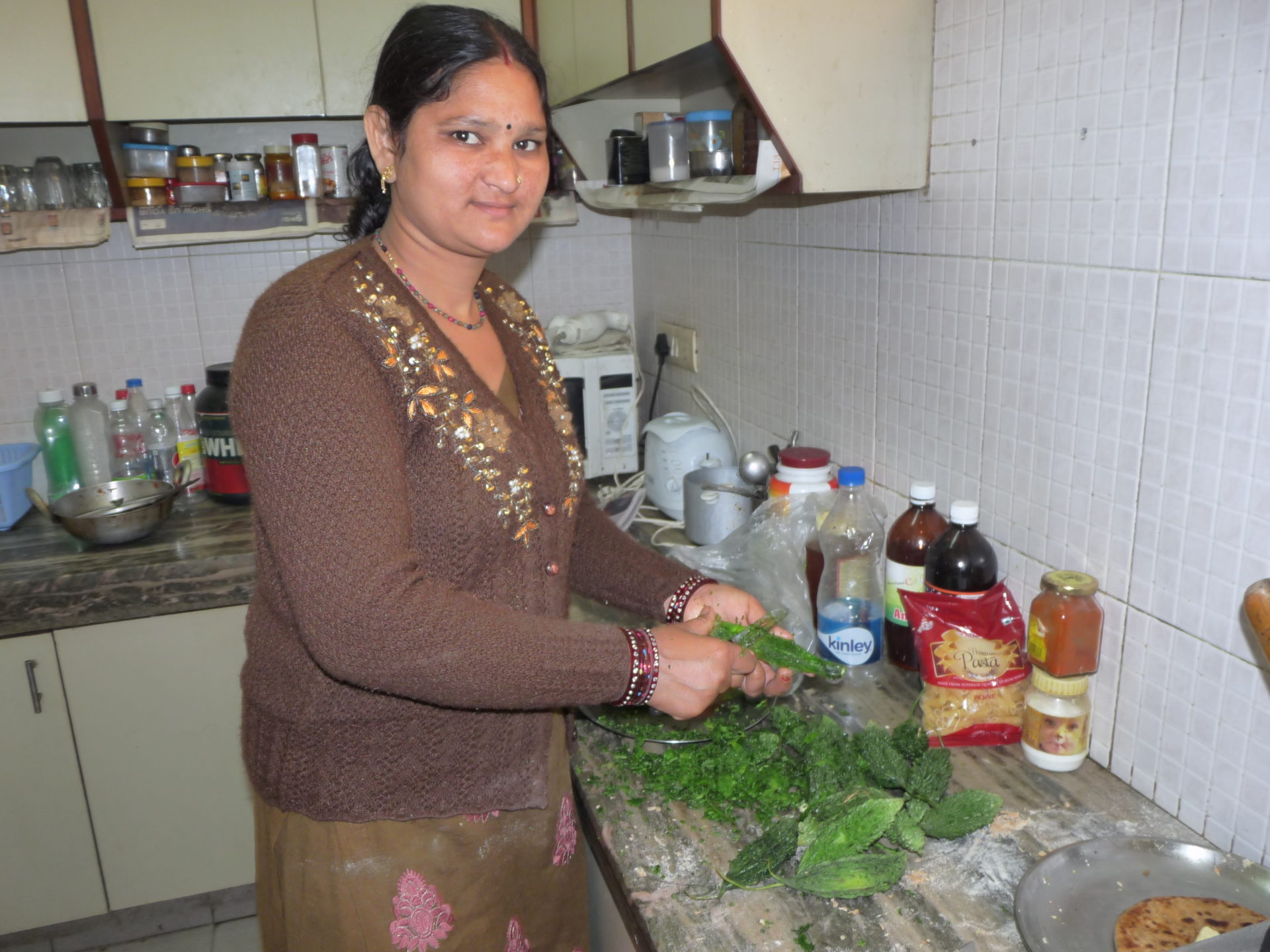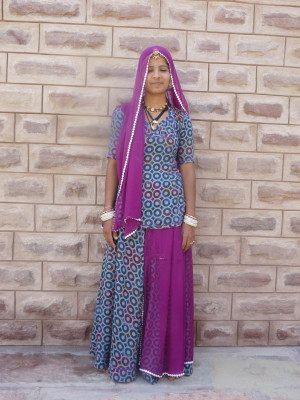Actually, my headline is already wrong. You can’t actually write about women in India in general. In India there is not the “typical woman”. Depending on the location, caste, and class, the female inhabitants differ greatly in their lives on the Indian subcontinent. Hardly any life is like the other.
With this article, I am not trying to create a complete picture of the Indian women, but rather want to make it clear that every woman is individual and that there is no sterotype woman in India.

I will introduce you to five different women in this article, all of them Indians, each one is different, and I hope that with this article I will contribute to the fact that we are a little more careful with the assessment of an Indian woman’s life.
Shumni, Indian housewife

Shumni is 31 years old and lives with her two children Ansul (3 years) and Namika (6 years) and Ashok, her husband, in the small mountain village Kanol. They live in a house of their own, that Ashok built three years ago, a year after their wedding, because the space in his parental house was no longer enough.

Shumni never attended school and cannot read or write. But these skills are not needed during her hard daily work routine. Since a small girl, her skills were taught by her mother, aunts, and sisters. These skills now allow her to care for her family at home. Shumni grew up together with her six siblings in the neighbouring village, 3 km away from Kanol. Her marriage was arranged by her parents and after the marriage she moved to her husband’s village. At first it was hard to leave her friends and family behind, but she often visits her old home and quickly became friends with the other women, all of whom are actually born outsiders.
her daily working day starts early at 5 am. She washes herself, sets fire and feeds her children and the three cows. The children go to the village school at 8:30 am. Her husband Ashok is hardly at home, especially in the summer months, as he can be hired as a worker either at road construction sites or for treks with tourists in the mountains.
After 8:00 am,, Shumni leaves the house to climb a hill with the other women. Wood, grass for the cows and edible plants are collected here – after four hours she returns home. She prepares lunch consisting of self-collected wild plants and chapatis (flat bread) made from corn flour that comes from their corn fields.

After lunch, laundry is washed by hand at the fountain, the house is cleaned or new clothes are sewn. She also turns cow’s milk into fresh yoghurt and butter. In the afternoon she goes to the fields, either to fenugreek leaves, nettles or mustard leaves for dinner, or to take care of the grain.
After returning home, it is time to cook the next meal on open fire. At 6 o’clock the cows are milked and fed, around 8 o’clock dinner is served. For the meals she uses almost exclusively own products, almost nothing is bought in shops.

At the meal, Shumni serves the food to her two children and her husband and will have her own meal later.
Until 9 o’clock there is still a little time for sitting at the fire to talk, then all go to bed early.
Shumni does not seem unhappy, but strong and calm. She usually spends the day at work with the other women and chats a lot then.
She accepts the work as it is. It just needs to be done.
Hamreet, housewife in Delhi
Hamreet is also a housewife and is proud of it. To anyone who wants to hear it, she tells us in perfect English that although she has a bachelor’s degree, the degree is of no use to her, since she is now a full-time mother and wife: “I never have free time, work from morning to evening, all week long!” she says with a played moan.

I am curious and am invited by her to spend a day with her at home.
Hamreet lives in a joint family of her husband and with her three-year-old son.
You often hear horror stories about how the poor wives are taken under the wings of their mother-in-law. But when I was at home with her, the connection between mother-in-law and daughter-in-law seemed very loving and intimate. While the husbands are at work, the three women have the home for themselves and live together wonderfully.

Hamreet is 25 years old. She belongs to the Sikh religion and was engaged 10 years ago to her current husband, whom she married at a age of 19. “Out of friendship became love!” she tells me quite openly. And indeed, when I watch the two, I can see how loving they are with each other. I am surprised how she combines the traditional and modern parts of her life: she has the latest smartphone and is on Facebook, often dresses in jeans and dresses, goes shopping and to the cinema. On the other hand, she doesn’t cut her hair for religious reasons, prays daily, serves the food to her husband and is at home whole day.
But as I was able to see on the day of my visit, Hamreet house hold work is quit limited. The family is very wealthy and there is a permanent girl who washes the laundry, does the dishes and cleans the house. The preparation of the food alone is the task of the ladies. They want to cook themselves, after all, it’s what they do best!

In addition, Hamreet takes a lot of care for her own beauty: She is busy going to the Beauty Parlour, every day make up is applied and the tailor comes to her home to cut the most beautiful dresses and traditional suits for her.
Her husband takes her out regularly and every month she goes to the Kitty Party, a coffee wreath for women.
Hamreet’s daily routine looks something like this:
7:00-8:00 am She washes herself and prays
8:00 am She wakes up her husband and child
8:30 am Alternately with her sister-in-law she prepares breakfast
9:30 am Breakfast
10:00 am The men leave the house
10:00 am -12:00 pm She sorts things out…
12:30 pm son comes from school and is cared for
2:00 pm The women eat lunch cooked by their mother-in-law
3:00-6:00 pm Long nap
6:00 pm Snacks and tea
6:30-9:00 pm Preparation of dinner (alternating with her sister-in-law)
9:00 pm The men come home
9:30 pm Dinner
10:30 pm Prayer
11:00 pm Sleeping
A daily routine that seems feasible.
Read the Interview with Hamreet here.
Savita
Savita lives in Delhi with her husband and two children and is the cook of a friend of mine. Her husband works as a guard, the two children go to school and she works for families at their home.
Every day, she prepares the food for five different households in a row.

In Delhi and other major cities, it is common for the wealthier middle class to afford cleaners, laundry women and cooks who work at home for them.
Every day from 8:30 am to 10:30 am, Savita comes to my friend’s apartment and prepares breakfast and dinner for him and his two roommates. The ingredients are bought weekly by the residents and they decide individually on the daily dishes.
Before she comes to my friends place, she has already been at the home of two other families and will go to two more apartments to cook afterwards. At 5:30 pm she’s done cooking. She is a good cook and is often recommended by her employers to friends. For each person she cooks, she takes 1000 rupees a month. In total, she makes eleven thousand rupees, which is equivalent to about 190 euros. A relatively good earning in addition to her husbands salary.

In addition, of course, she must also carry out all the necessary work at home. Here, too, she cooks, washes the laundry and keeps the house clean.
Savita is a confident and communicative woman. When I lived at my friends place for a couple of days and entered into the kitchen, She nailed me in Hindi and engaged me in a conversation, although my Hindi is rather bad and brittle.
Dikschika
Dikschika is a twenty-three-year-old student who is currently doing her master’s degree. She comes from Utthrakand, a mountain state of India, and now lives in Delhi with her two siblings in an apartment owned by the wealthy family.

She speaks fluent English, is beautiful and dresses more modernly than I do. She often stays her boyfriends place, goes shopping with friends or to the cinema and often eats out of the house.
Her great passion is dancing. At the moment she follows her passion more than her studies and attends dance lessons during her lecture time. She often comes home late at night and sleeps until noon the next morning.

All doors are open for her and she does and will do what she wants and thinks is right. Dikshika is one of our tour guides as well.
Ragu
Ragu is 20 and from Rajasthan. She was married to her husband at the age of 17 and has lived with his family ever since and takes care of the household. He himself is not there most of the time, as he owns a clothing store in Karnataka.

Ragu is dressed in the typical clothing of a Rajasthani Wife: long colorful skirts, lots of jewelry on ankles, ears and arms, a nose ring and of course a transparent veil that only makes her beautiful face more interesting.
Unlike many other Rajasthani women, Ragu went to school until 12th grade and graduated. Even though she barely sees her husband, she loves him and now hopes for a child. Whether girl or boy, she doesn’t care. She herself has seven siblings, but only wants two children.
Her husband is on holiday for a month and for a few days they went to an ashram together.

Here in this ashram I got to know the two together. She is very self-confident, but also diligent and does the work without complaining.
She is here to learn English and is supported by her husband. He also agrees that she is allowed to work as a yoga teacher here in the ashram at a girls’ camp!
Ragu is a great woman who seems happy. Like the other women, she is not to comfortable with men and at major events and festivals in Rajasthan, she sits with the other women separated from the men.

She is very open to me and she became a very good friend to me here in the ashram. She taught me how to prepare Rajasthani dishes, decorated my hands with hennaand made jokes in a mixed-mash of English and Hindi. We had a lot of fun together in the yoga classes, in which she appeared without a headscarf and with gym pants! Keep it up, girls from Rajasthan and all over India!






